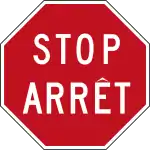Comparison of MUTCD-influenced traffic signs
Road signs used by countries in the Americas are significantly influenced by the Manual on Uniform Traffic Control Devices (MUTCD), first released in 1935, reflecting the influence of the United States throughout the region.[1] Other non-American countries using road signs similar to the MUTCD include Australia, Indonesia, Ireland, Japan, Malaysia, New Zealand, and Thailand. They, along with the US Virgin Islands, are also the only countries listed here which drive on the left—with the exception of Liberia and the Philippines (though partial), both of which drive on the right.
There are also a number of American signatories to the Vienna Convention on Road Signs and Signals: Argentina, Brazil, Chile, Cuba, Ecuador, French Guiana, Paraguay, Venezuela, and Suriname. Of those, only Chile, Cuba, and French Guiana have ratified the treaty.
Mandatory action signs in the Americas tend to be influenced by both systems. Nearly all countries in the Americas use yellow diamond warning signs. Recognizing the differences in standards across Europe and the Americas, the Vienna convention considers these types of signs an acceptable alternative to the triangular warning sign. [2] However, UN compliant signs must make use of more pictograms in contrast to more text based US variants. Indeed, most Pan-American nations make use of more symbols than allowed in the US MUTCD.
It is also worth noting that, unlike in Europe, considerable variation within road sign designs can exist within nations, especially in multilingual areas.
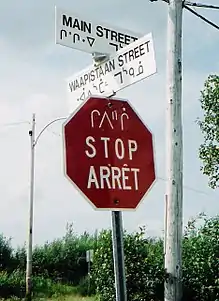
Differences between MUTCD-influenced traffic signs
The main differences between traffic signs influenced by the MUTCD relate to:
- Graphic design and symbological details
- The use of square-bordered or circular regulatory signs
- Local languages (signs may be bilingual or trilingual)
- Most notable is the text on stop signs. Unlike in Europe, the text on stop signs in the Americas varies depending on language, and may be multilingual.
Languages
Below is a table of the main languages used. Note that in non-English speaking countries, English is frequently included on signs near airports and tourist areas.
| Argentina | Australia | Brazil | Anglophone Canada | Quebec |
Chile | Colombia | Indonesia | Ireland | Jamaica | Japan | Liberia | Malaysia | Mexico | New Zealand | Panama | Peru | Philippines | Thailand | United States | Uruguay | |
|---|---|---|---|---|---|---|---|---|---|---|---|---|---|---|---|---|---|---|---|---|---|
| Drives on the… | Right | Left | Right | Right | Right | Right | Right | Left | Left | Left | Left | Right | Left | Right | Left | Right | Right | Right | Left | Right | Right |
| Primary language | Spanish | English | Portuguese | English | French | Spanish | Spanish | Indonesian | Irish and English[3] |
English | Japanese | English | Malay | Spanish | English | Spanish | Spanish | English | Thai | English | Spanish |
| Secondary language(s) |
|
|
|
|
|
|
|
||||||||||||||
| Typical typeface(s) | Helvetica, FHWA |
FHWA | FHWA (modified) | Clearview, FHWA (varies by province) |
FHWA, Clearview (different fonts specified for different signs) | Ruta CL, formerly FHWA |
Helvetica, FHWA |
Clearview, formerly FHWA | Transport | FHWA | Hiragino (Japanese) & Vialog (English), formerly Helvetica (English) |
Clearview, formerly FHWA | LLM (for expressways) & Transport (for federal & state highways), formerly FHWA |
FHWA | FHWA | Helvetica | FHWA (modified) | Clearview, formerly Arial Bold and FHWA (still used on expressway sections) |
FHWA (English) | FHWA, Clearview (varies by state) |
Helvetica |
Differences in units
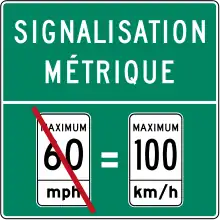
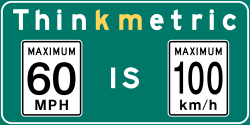
- All countries, with the exception of the United States and Great Britain, use the metric system. Some countries mark this fact by using units on various signs.
- Brazil, Indonesia, Ireland, Mexico, Panama, Peru, and parts of Canada (British Columbia, parts of Ontario, and Yukon) list units (km/h) on their maximum speed limit. In Canada and Ireland, this is a reflection of (somewhat) recent transitions from Imperial to metric.
- The US territory of Puerto Rico uses a mix - speed limits are in mph but distance signs are marked in km.
- Advisory speed limit signs in most countries list units, although New Zealand does not. The US lists units in mph.
- Height, weight, and width restrictions are almost always accompanied by units (tonnes or metres); in the US, the short ton is used with no distinction from metric tonnes.
- Signs in some parts of Canada and Mexico near the US border often include both metric and Imperial units, to remind American drivers that they are entering metric countries. In Canada, these signs display the imperial speed limit using a Canadian-style sign, rather than an MUTCD-standard used in the US. No such equivalent exists in the US.[6]
- The US was, at one time, planning a transition to the metric system. The Metric Conversion Act of 1975 started the process, but it was halted in 1982. The MUTCD has guidelines for posting metric versions of speed limit signs on roads.
- The SI standard unit of speed, meter per second, is not used on road signs anywhere in the world. All countries that use the metric system measure speeds in kilometers per hour.
Warning signs
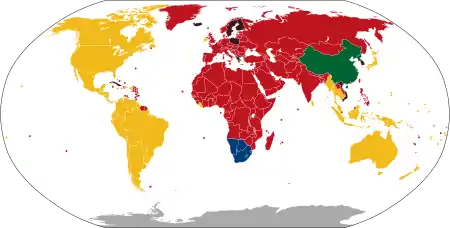
- Nearly all MUTCD-influenced warning signs are diamond-shaped and yellow; some warning signs may be fluorescent yellow-green in order to draw extra attention. There are a few exceptions to this:
- Pentagonal signs are used in school zones in the United States, Liberia, Mexico, Malaysia, Thailand and many areas in Canada. In Japan and the Philippines, pentagonal signs are permanently used for pedestrian crossings.
- Argentina employs European-style red-bordered triangular warning signs in certain instances where extra attention is required. The Philippines uses this style for most warning signs, though some highways like the Subic–Clark–Tarlac Expressway and the Manila–Cavite Expressway use MUTCD-style yellow diamond-shaped warning signs.
- Warning signs may be text-only.
Road works and construction
- Most countries do not use orange or yellow diamond-shaped signs for construction zones. Australia and the Philippines instead use rectangular signs that fit into temporary casings.
Regulatory signs
- Prohibitory and restrictive signs are classified as regulatory signs, as per the MUTCD.
- Almost all prohibitory signs use a red circle with a slash. Restrictive signs typically use a red circle, as in Europe. Some may be seated on a rectangular white background.
- The original MUTCD prohibitory and restrictive signs were text-only (i.e. NO LEFT TURN).[7] Some of these signs continue to be used in the US.
- The No Entry / Do Not Enter sign may or may not feature text. In some Latin American countries, an upwards-pointing arrow contained within a slashed red circle is used instead. Some countries have those two signs separated.
- The Latin American-style 'do not proceed straight' sign may take a different meaning in countries with standard No Entry / Do Not Enter signs. Typically, it indicates an intersection where traffic cannot continue straight ahead (often involving a one-way street to be exact), but where cross-traffic may enter the street from the right (or left). Thus, it is distinguished from a No Entry / Do Not Enter (for all vehicles) sign.
Mandatory or permitted-action signs
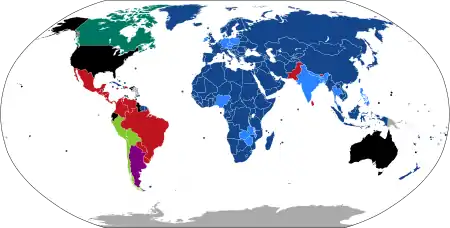
- The design of mandatory signs varies widely, since the MUTCD does not specify their use.[1] Rather, the MUTCD's equivalent are classified as regulatory signs.
- Some countries use simple arrows with the text "ONLY" or its equivalent underneath. This is the MUTCD standard.
- Some countries use European-style white-on-blue circular signs. These are "Type A Mandatory Signs" as prescribed by the Vienna Convention.
- Some Latin American countries use red-bordered circular signs, in the same style as regulatory signs. These are "Type B Mandatory Signs" as prescribed by the Vienna Convention. In cases relating to particular types of vehicle traffic (e.g. buses), these signs are identical to some European prohibitory signs.[lower-alpha 1]
- Canada uses a unique style of mandatory sign that features a green circle.
Highway and wayfinding signs
- Most countries use white-on-green signs on highways and to indicate location, etc.
- The exact style of these signs varies widely, although many are influenced by the MUTCD standard.
- Chile, Ireland, Japan, and New Zealand use both white-on-green and white-on-blue guide signs, as does the Northwest Territories and Ontario in Canada.
- Malaysia uses both black-on-yellow and white-on-green guide signs.
- White-on-blue signs are sometimes used at airports and for rest areas.
- White-on-brown signs are sometimes used to indicate park areas.
Gallery of Guide Signs
 Argentina
Argentina Australia (Queensland)
Australia (Queensland) Brazil (São Paulo)
Brazil (São Paulo) Canada (British Columbia)
Canada (British Columbia) Canada (Ontario)
Canada (Ontario) Canada (Quebec)
Canada (Quebec) Chile
Chile Colombia
Colombia Indonesia
Indonesia Ireland
Ireland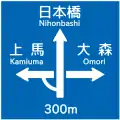 Japan
Japan Malaysia
Malaysia Mexico (Veracruz)
Mexico (Veracruz) New Zealand
New Zealand Panama
Panama Peru
Peru Philippines
Philippines Thailand
Thailand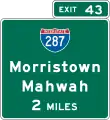 United States (New Jersey)
United States (New Jersey)
Table of traffic signs comparison
Warning
Argentina |
Australia |
Brazil |
Canada |
Canada - British Columbia |
Canada - Ontario |
Canada - Quebec |
Chile |
Colombia |
Indonesia |
Ireland |
Jamaica |
Japan |
Liberia |
Malaysia |
Mexico |
New Zealand |
Panama |
Peru |
Philippines |
Thailand |
United States (Graphical and textual— used interchangeably) |
Uruguay | |
|---|---|---|---|---|---|---|---|---|---|---|---|---|---|---|---|---|---|---|---|---|---|---|---|
| Stop sign ahead | .svg.png.webp) |
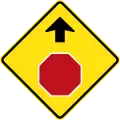 |
 |
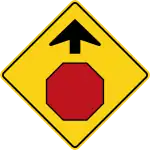 |
 |
 |
 |
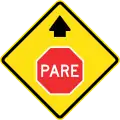 |
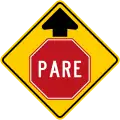 |
_1a.svg.png.webp) |
 |
 |
Not used |  |
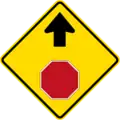 |
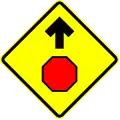 |
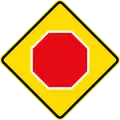 |
 |
 |
 |
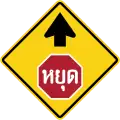 |
 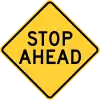 |
 |
| Yield/Give Way sign ahead | .svg.png.webp) |
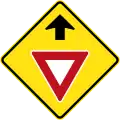 |
? |  |
 |
 |
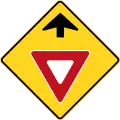 |
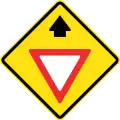 |
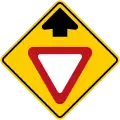 |
_1b.svg.png.webp) |
 |
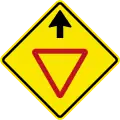 |
Not used |  |
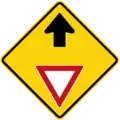 |
 |
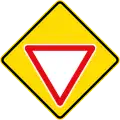 |
 |
 |
 |
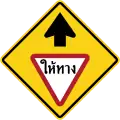 |
  |
? |
| Traffic signals ahead |  |
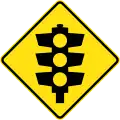 or 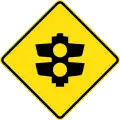 |
 |
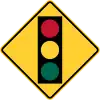 |
 |
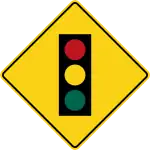 |
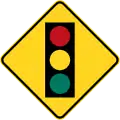 |
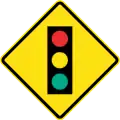 |
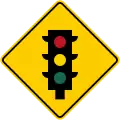 |
 |
 |
 |
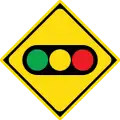 |
 |
 |
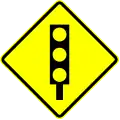 |
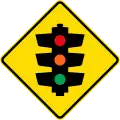 |
 |
 |
 |
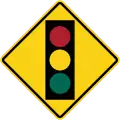 |
  |
 |
| Roundabout ahead |  |
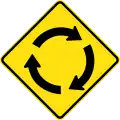 |
 |
 |
 |
 |
 |
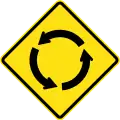 |
 |
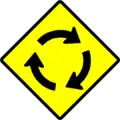 |
 or  |
 |
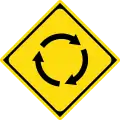 |
 |
 |
 |
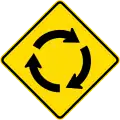 |
 |
 |
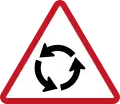 |
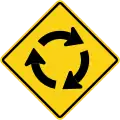 |
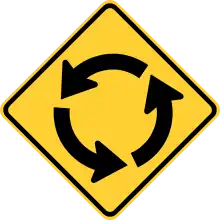  [lower-alpha 2] |
 |
| Two-way traffic ahead |  |
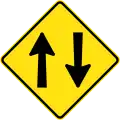 |
 |
 |
 |
 |
 |
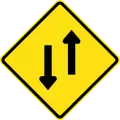 |
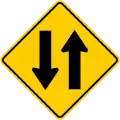 |
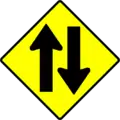 |
 |
 |
 |
 |
 |
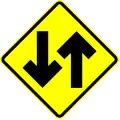 |
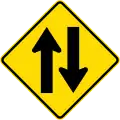 |
 |
 |
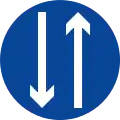 |
 |
 |
 |
| Uncontrolled railroad crossing ahead |  |
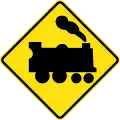 |
 |
 |
 |
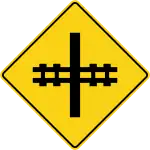 |
 |
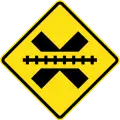 |
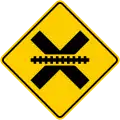 |
 |
 |
 |
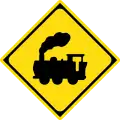 |
 |
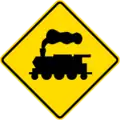 |
 |
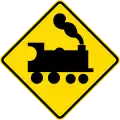 |
 |
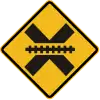 |
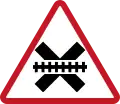 |
 |
 |
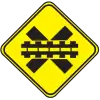 |
| Level railroad crossing with barriers ahead |  [lower-alpha 3] |
 |
 |
 [lower-alpha 3] |
 [lower-alpha 3] |
 [lower-alpha 3] |
 [lower-alpha 3] |
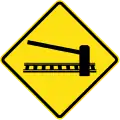 |
 |
 |
 or  |
 |
 [lower-alpha 3] [lower-alpha 3] |
 |
 |
 [lower-alpha 3] |
 |
 or 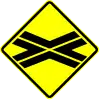 |
 |
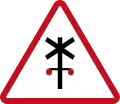 |
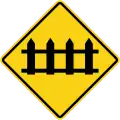 |
 |
 |
| Tram / streetcar crossing |  |
 |
 |
Not used | Not used | Not used | N/A [lower-alpha 4] |
N/A [lower-alpha 4] |
N/A [lower-alpha 4] |
Not used |  |
N/A [lower-alpha 4] |
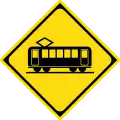 |
N/A [lower-alpha 4] |
Not used | N/A [lower-alpha 4] |
.svg.png.webp) |
Not used | N/A [lower-alpha 4] |
N/A [lower-alpha 4] |
Not used |  [lower-alpha 5] |
 |
| Railroad crossbuck | 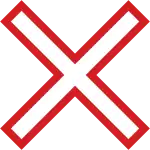 |
 |
 |
 |
Not used |  |
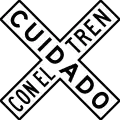 |
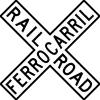 |
 |
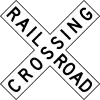 |
|||||||||||||
| Level crossing (multiple tracks) | .svg.png.webp) |

|

|

|

|
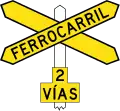 |
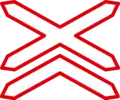 |
Not used | ? | 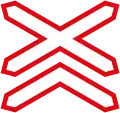 |
 |
.svg.png.webp) |
 |
 |
 |
 |
|||||||
| Argentina | Australia | Brazil | Canada | Canada (British Columbia) |
Canada (Ontario) |
Canada (Quebec) |
Chile | Colombia | Indonesia | Ireland | Jamaica | Japan | Liberia | Malaysia | Mexico | New Zealand | Panama | Peru | Philippines | Thailand | USA | Uruguay | |
| Crossroads ahead |  |
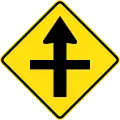 |
 |
 |
 |
 |
 |
 |
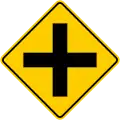 |
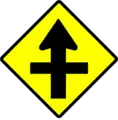 |
 |
 |
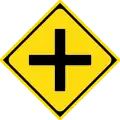 |
 |
 |
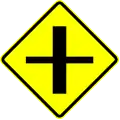 |
 |
 |
 |
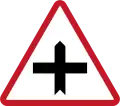 |
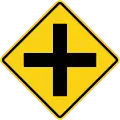 |
 |
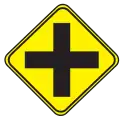 |
| Junction with a side road ahead |  |
 |
 |
 |
 |
 |
 |
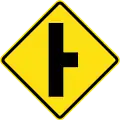 |
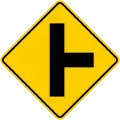 |
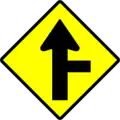 |
 |
 |
 |
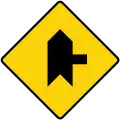 |
 |
 |
.svg.png.webp) |
 |
 |
 |
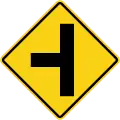 |
 |
 |
| Traffic merges ahead |  |
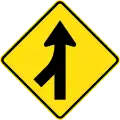 |
 |
 |
 |
 |
 |
 |
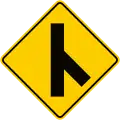 |
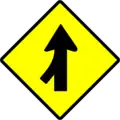 |
 |
? |  |
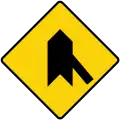 |
 |
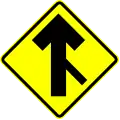 |
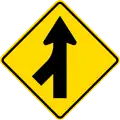 |
 |
 |
 |
 |
 |
 |
| Added lane | ? | 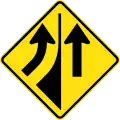 |
? |  |
 |
? |  |
? | ? | ? | ? | ? | ? | ? | ? | ? | 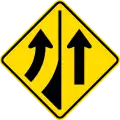 |
? | ? | ? | ? |  |
? |
| Divided highway ahead |  |
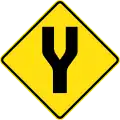 |
 |
 |
Flip sign below upside down |  |
 |
? | 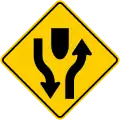 |
 |
 |
 |
Not used |  |
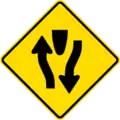 |
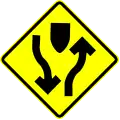 |
? |  |
 |
 |
 |
  |
 |
| Divided highway ends | ? | 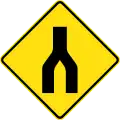 |
 |
 |
 |
 |
 |
? |  |
 |
 |
 |
Not used |  |
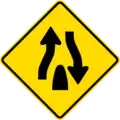 |
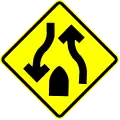 |
? |  |
 |
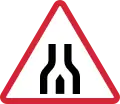 |
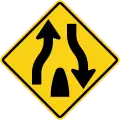 |
 |
 |
| Lane ends ahead |  |
 |
 |
 |
 |
 |
 |
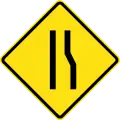 |
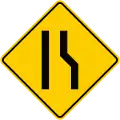 |
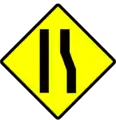 |
 |
 |
 |
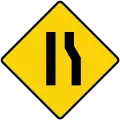 |
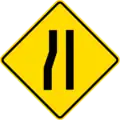 |
 |
.svg.png.webp) |
 |
 |
 |
  |
 | |
| Road narrows ahead |  |
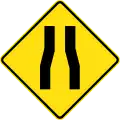 |
 |
 |
 |
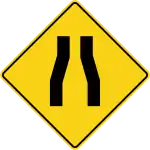 |
 |
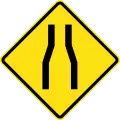 |
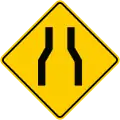 |
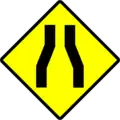 |
 |
 |
 |
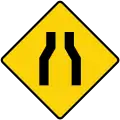 |
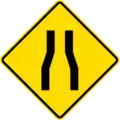 |
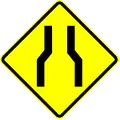 |
 |
 |
 |
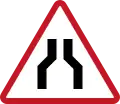 |
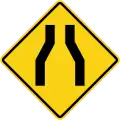 |
 |
 |
| Narrow bridge ahead |  |
 |
 |
 |
 |
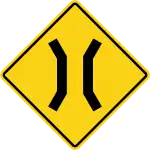 |
 |
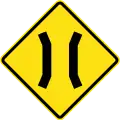 |
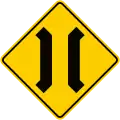 |
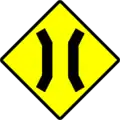 |
? |  |
Not used | 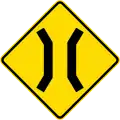 |
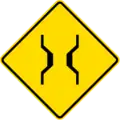 |
 |
 |
 |
 |
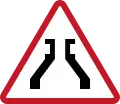 or  |
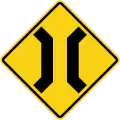 |
  |
 |
| Dangerous crosswinds |  |
 |
 |
 |
 |
? |  |
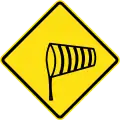 |
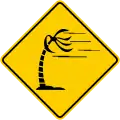 |
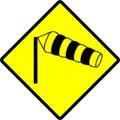 |
 |
 |
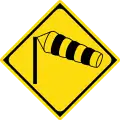 |
 |
 |
? | 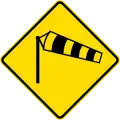 |
? | ? | Not used | ? |   [lower-alpha 6] |
 |
| Low-flying aircraft |  |
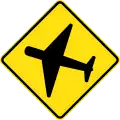 |
 |
 |
 |
? |  |
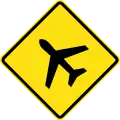 |
? | 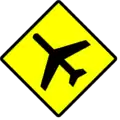 |
 |
 |
Not used |  |
? | ? |  |
 |
 |
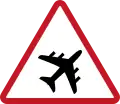 |
 |
 |
 |
| Steep grade downwards |  |
  |
 |
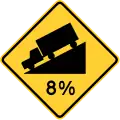 |
 |
 |
 |
 |
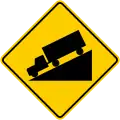 |
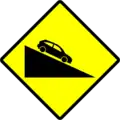 |
 |
 |
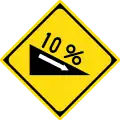 |
 |
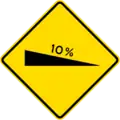 |
 |
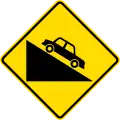 |
 |
 |
 and  |
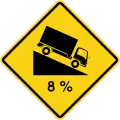 |
 or  |
 |
| Steep grade upwards |  |
 |
 |
 |
 |
Not used |  [lower-alpha 7] |
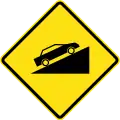 |
 |
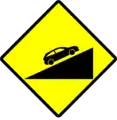 |
 |
 |
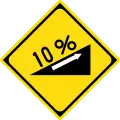 |
 |
 |
Not used |  |
 |
Not used |  and 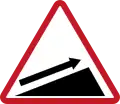 |
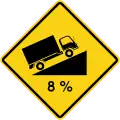 |
 |
 |
| Argentina | Australia | Brazil | Canada | Canada (British Columbia) |
Canada (Ontario) |
Canada (Quebec) |
Chile | Colombia | Indonesia | Ireland | Jamaica | Japan | Liberia | Malaysia | Mexico | New Zealand | Panama | Peru | Philippines | Thailand | USA | Uruguay | |
| Uneven surface |  |
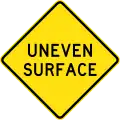 |
 |
 |
 |
 |
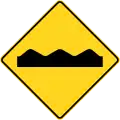 |
 |
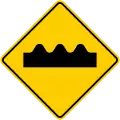 |
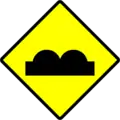 |
 |
 |
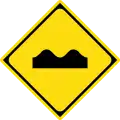 |
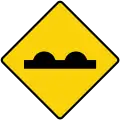 |
 |
 |
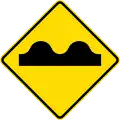 |
 |
 |
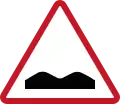 |
 |
 |
 |
| Bump in road |  |
 |
 |
 |
 |
 |
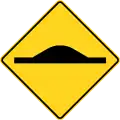 |
 |
 |
 |
 |
 |
 |
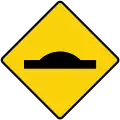 |
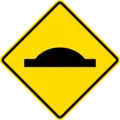 |
.svg.png.webp) |
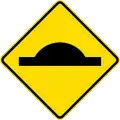 |
 |
 |
 |
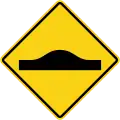 |
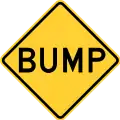 |
 |
| Bump Ahead | 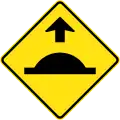 Sign used |
||||||||||||||||||||||
| Dip in road |  |
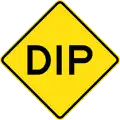 |
 |
 |
 |
? | 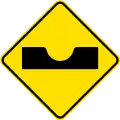 [lower-alpha 8] [lower-alpha 8] |
 |
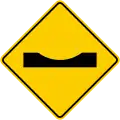 |
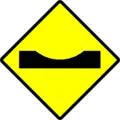 |
 |
? | Not used | 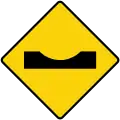 |
Not used | ? | 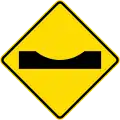 |
 |
 |
? |  |
 |
 |
| Slippery road surface |  |
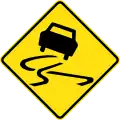 |
 |
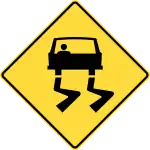 |
 |
 |
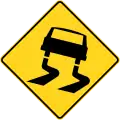 |
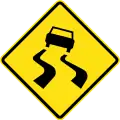 |
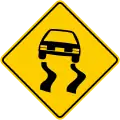 |
 |
 |
 |
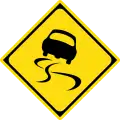 |
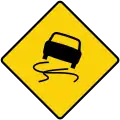 |
 |
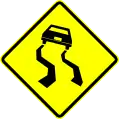 |
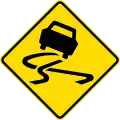 |
 |
 |
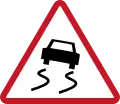 or  |
 |
 |
 |
| Loose road surface |  |
[lower-alpha 9] |
 |
 [lower-alpha 9] |
 |
Not used |  [lower-alpha 9] |
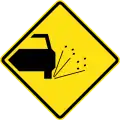 |
 |
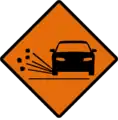 [lower-alpha 9] |
 [lower-alpha 9] |
 |
Not used |  |
Not used |  |
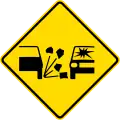 |
 |
 |
? |  |
 |
 |
| Pavement ends | ? | 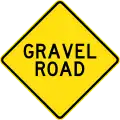 |
 |
 |
 |
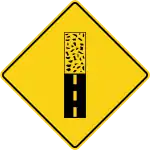 |
 |
? | 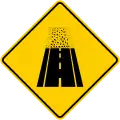 |
? | ? | ? | Not used | ? | Not used | 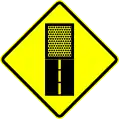 |
 |
 |
 |
? | ? |   |
 |
| Gentle curve ahead |  |
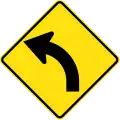 |
 |
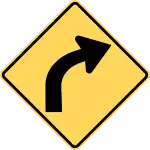 |
 |
 |
 |
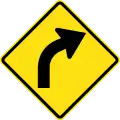 |
 |
 |
 |
 |
 |
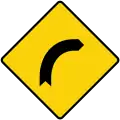 |
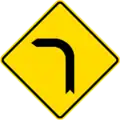 |
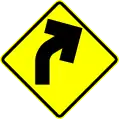 |
.svg.png.webp) |
 |
 |
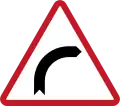 |
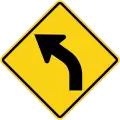 |
 |
 |
| Sharp curve ahead |  |
 |
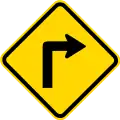 |
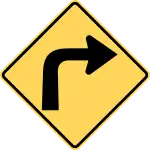 |
 |
 |
 |
 |
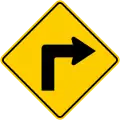 |
 |
 |
? |  |
 |
 |
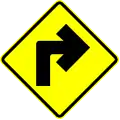 |
.svg.png.webp) |
 |
 |
 |
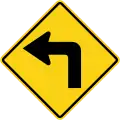 |
 |
 |
| Double gentle curve ahead |  |
||||||||||||||||||||||
| Double sharp curve ahead |  |
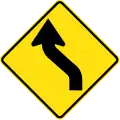 |
 |
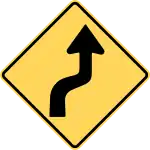 |
 |
 |
 |
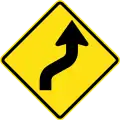 |
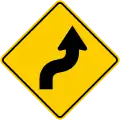 |
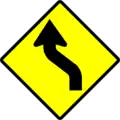 |
 |
 |
 |
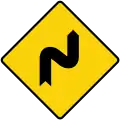 |
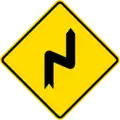 |
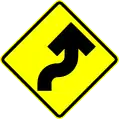 |
.svg.png.webp) |
 |
 |
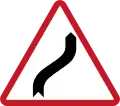 |
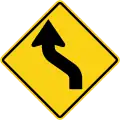 |
 |
 |
| Series of curves ahead |  |
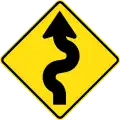 |
 |
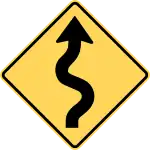 |
 |
 |
 |
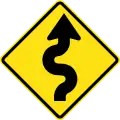 |
 |
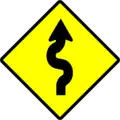 |
 |
 |
 |
Not used |  |
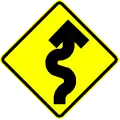 |
.svg.png.webp) |
 |
 |
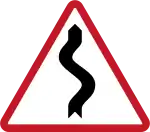 |
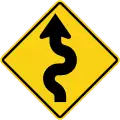 |
 |
 |
| Hairpin curve ahead | ? | 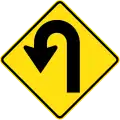 |
Not used | Not used | 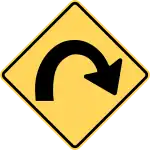 |
 |
 |
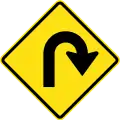 |
 |
? | ? | ? | Not used | Not used | Not used |  |
.svg.png.webp) |
 |
 |
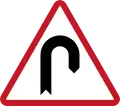 |
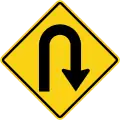 |
 |
 |
| Argentina | Australia | Brazil | Canada | Canada (British Columbia) |
Canada (Ontario) |
Canada (Quebec) |
Chile | Colombia | Indonesia | Ireland | Jamaica | Japan | Liberia | Malaysia | Mexico | New Zealand | Panama | Peru | Philippines | Thailand | USA | Uruguay | |
| School zone |  |
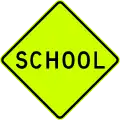 |
 |
 |
 |
 |
 |
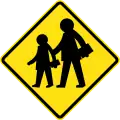 |
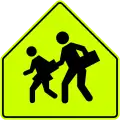 |
 |
 |
 |
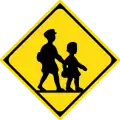 |
 |
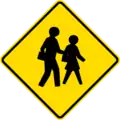 |
 |
 |
 |
 |
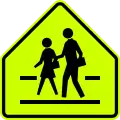 |
 |
 |
 |
| Children / playground ahead |  |
 |
 |

or
|

or
|
 |
 |
 |
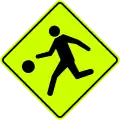 |
 |
 |
 |
 |
 |
 |
 |
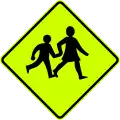 |
 |
 |
 |
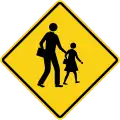 |
.svg.png.webp) |
 |
| Pedestrians / crossing ahead | ? |  or  |
 or  |
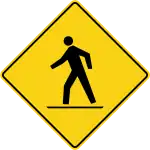 |
 |
 or .svg.png.webp) |
 |
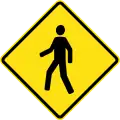 or 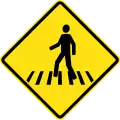 |
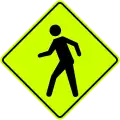 or  |
 |
 |
 |
Not used |  |
 |
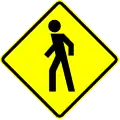 |
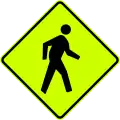 or  |
 |
 |
 |
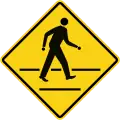 |
.svg.png.webp) |
 |
| Pedestrian crossing |  |
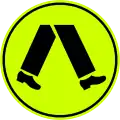 |
 |
 |
 |
 |
 |
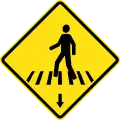 |
 |
 |
 |
 |
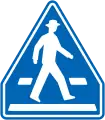 or 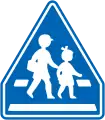 |
 |
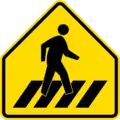 |
 |
 |
Not used |  or 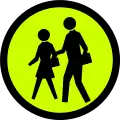 |
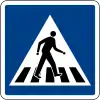 |
.svg.png.webp) |
 | |
| Cyclists crossing |  |
 |
 |

or
|
 |
 |
 |
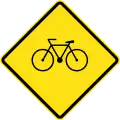 |
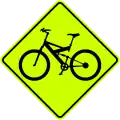 |
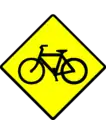 |
 |
 |
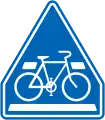 |
 |
? | 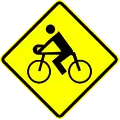 |
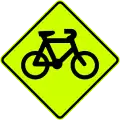 |
 |
 |
 |
? |  |
 |
| Falling rocks or debris |  |
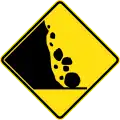 |
 |
 |
 |
 |
 |
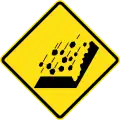 |
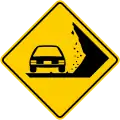 |
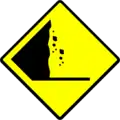 |
 |
 |
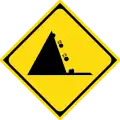 |
 |
 |
 |
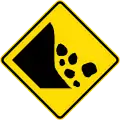 |
 |
 |
 |
 |
  [lower-alpha 6] |
 |
| Argentina | Australia | Brazil | Canada | Canada (British Columbia) |
Canada (Ontario) |
Canada (Quebec) |
Chile | Colombia | Indonesia | Ireland | Jamaica | Japan | Liberia | Malaysia | Mexico | New Zealand | Panama | Peru | Philippines | Thailand | USA | Uruguay | |
| Opening or swing bridge | Not used |  |
 |
 |
 |
 |
 |
? | ? |  |
 |
 |
Not used |  |
? | 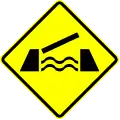 |
? |  |
? | 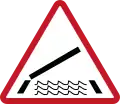 |
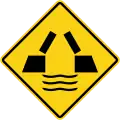 |
 |
 |
| Emergency vehicles |  |
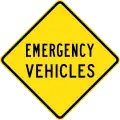 |
Not used |  |
 |
 |
 |
? |  |
Not used | ? | N/A | Not used | 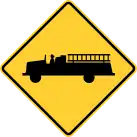 |
Not used | Not used |  |
Not used |  |
Not used | Not used |   |
? |
| Farm vehicles |  |
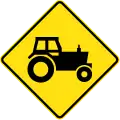 |
 |
 |
 |
 |
 |
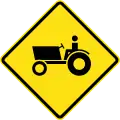 |
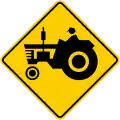 |
? |  |
N/A | Not used |  |
Not used | 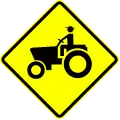 |
? |  |
 |
Not used | Not used |   |
 |
| Domestic animals |  |
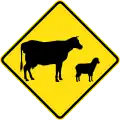 |
 |
 |
 |
 |
 |
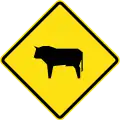 |
.svg.png.webp) |
 |
 |
? | ? |  |
 |
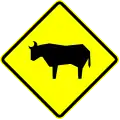 |
 |
 |
 |
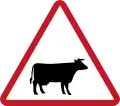 |
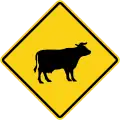 |
 |
 |
| Wild animals |  |
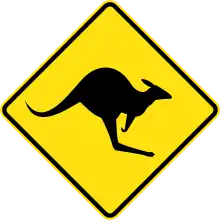 |
 |
 |
 |
 |
 |
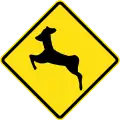 |
.svg.png.webp) |
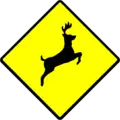 |
 |
? | 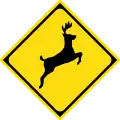 |
 |
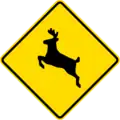 |
? | 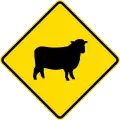 |
 |
? | Not used | ? |  |
 |
| Equestrians |  |
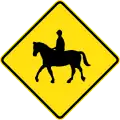 |
Not used |  |
 |
 |
 |
? | ? | ? |  |
N/A | Not used |  |
? | ? | 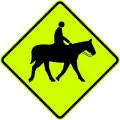 |
? | ? | Not used | Not used |  |
 |
| Tunnel ahead |  |
? | Not used |  |
 |
? |  |
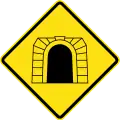 |
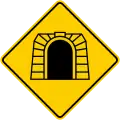 |
? |  |
 |
Not used |  |
Not used | ? |  |
? |  |
? | ? | 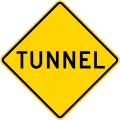 |
? |
| Height restriction ahead |  |
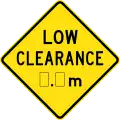 |
 |
 |
 |
 |
 |
 |
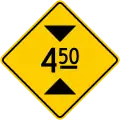 |
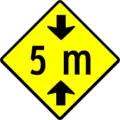 |
 |
N/A | Not used |  |
Not used | .svg.png.webp) |
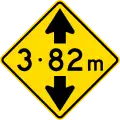 |
? |  |
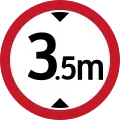 |
 |
 |
 |
| Width restriction ahead |  |
Not used |  |
Not used | Not used |  [lower-alpha 9] |
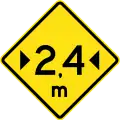 |
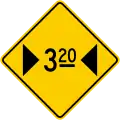 |
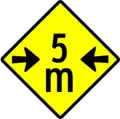 |
 |
? | Not used |  |
Not used | .svg.png.webp) |
Not used |  |
 |
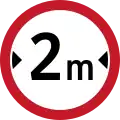 |
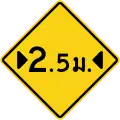 |
N/A |  | |
| Length restriction ahead | ? | ? |  |
? | ? | ? | ? | ? | ? | ? | ? | ? | ? | ? | ? | ? | ? | ? | ? | 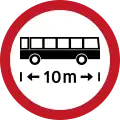 |
? | ? | ? |
| Weight restriction ahead |  |
Not used |  |
Not used |  |
 |
 |
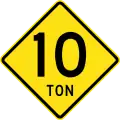 |
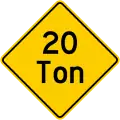 |
Not used |  |
N/A | Not used | Not used | Not used | ? | Not used | ? | ? | 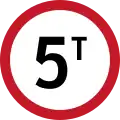 |
Not used |  |
? |
| Roadworks [lower-alpha 9] |
? |  |
 or  |
 or  |
 or  |
 or  |
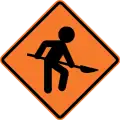 |
 |
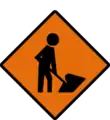 |
 |
 |
 |
 |
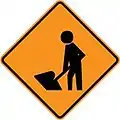 |
? | 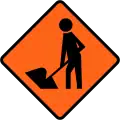 |
 |
 |
Not used |  |
 |
 | |
| Flagman Ahead |  |
Not used |  |
 |
 |
 |
 |
 |
 |
||||||||||||||
| Argentina | Australia | Brazil | Canada | Canada (British Columbia) |
Canada (Ontario) |
Canada (Quebec) |
Chile | Colombia | Indonesia | Ireland | Jamaica | Japan | Liberia | Malaysia | Mexico | New Zealand | Panama | Peru | Philippines | Thailand | USA | Uruguay |
Regulatory
Argentina |
Australia |
Brazil |
Canada |
Canada - British Columbia |
Canada - Ontario |
Canada - Quebec |
Chile |
Colombia |
Indonesia |
Ireland |
Japan |
Malaysia |
Mexico |
New Zealand |
Panama |
Peru |
Philippines |
Thailand |
United States |
USA - Puerto Rico |
Uruguay | |
|---|---|---|---|---|---|---|---|---|---|---|---|---|---|---|---|---|---|---|---|---|---|---|
| Stop |  |
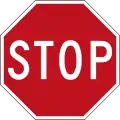 |
 |
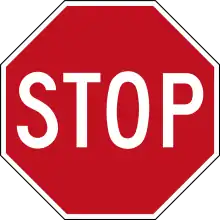
Everywhere
(N.B) |
 |
 |
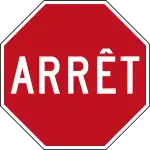 |
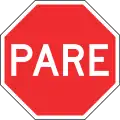 |
 |
_1a.svg.png.webp) |
 |
 |
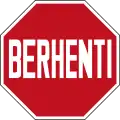 |
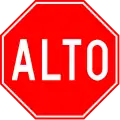 |
 |
 |
 |
 |
 |
 |
 |
 |
| Yield / Give Way |  |
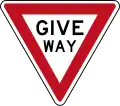 |
 |
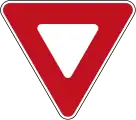 |
 |
 |
 |
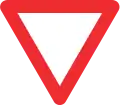 |
 |
_1b.svg.png.webp) |
.svg.png.webp) or .svg.png.webp) |
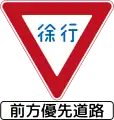 |
 |
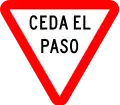 |
 |
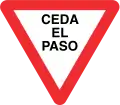 |
 |
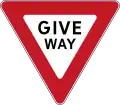 or  |
 |
 |
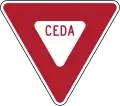 |
 |
| Yield to oncoming traffic |  |
 or 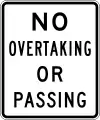 [8] [8] |
? |  |
 |
 |
 |
 |
 |
 |
Not used | Not used |  |
? |  |
? | ? | ? |  |
 |
? | ? |
| No entry |  or  |
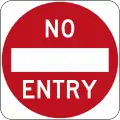 or  |
 |
 |

or
|
 |
 |
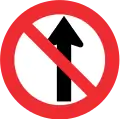 |
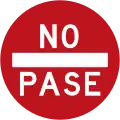 |
 |
 or  |
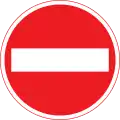 |
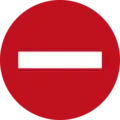 |
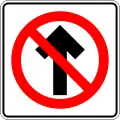 |
 |
 or  |
 or  |
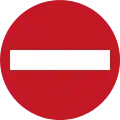 or  |
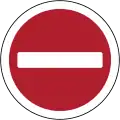 |
 |
 |
 or  |
| Road closed | ? | or |
? |  [lower-alpha 9] |
 [lower-alpha 9] |
? |  |
 |
? | 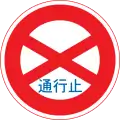 |
? | ? | 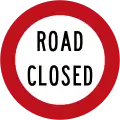 |
? | ? | ? |  | |||||
| Argentina | Australia | Brazil | Canada | Canada (British Columbia) |
Canada (Ontario) |
Canada (Quebec) |
Chile | Colombia | Indonesia | Ireland | Japan | Malaysia | Mexico | New Zealand | Panama | Peru | Philippines | Thailand | USA | USA (Puerto Rico) |
Uruguay | |
| No motor vehicles | .svg.png.webp) |
? |  |
 |
 |
 |
 |
 |
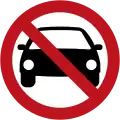 |
 |
 |
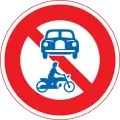 |
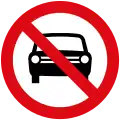 |
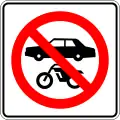 or 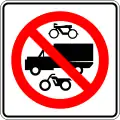 |
? |  |
 |
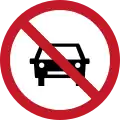 |
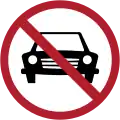 |
 |
? |  |
| No motorcycles | .svg.png.webp) |
? |  |
 |
Not used |  |
 |
 |
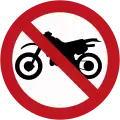 |
 |
Not used | 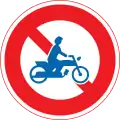 |
 |
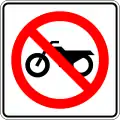 |
 |
 |
 |
 |
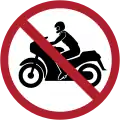 |
 |
? |  |
| No bicycles | .svg.png.webp) |
 |
 |

|
 |
 |
 |
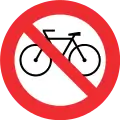 |
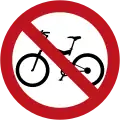 |
 |
 |
 |
.svg.png.webp) |
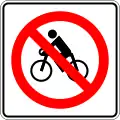 |
.svg.png.webp) |
 |
 |
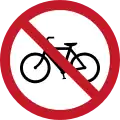 |
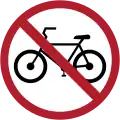 |
 |
? |  |
| No pedestrians | .svg.png.webp) |
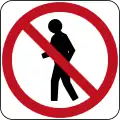 |
 |
 |
 |
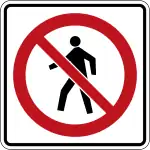 |
 |
 |
 |
 |
 |
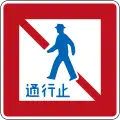 |
.svg.png.webp) |
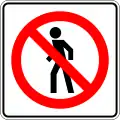 |
.svg.png.webp) |
 |
 |
 |
 |
 |
? |  |
| No heavy goods vehicles | .svg.png.webp) |
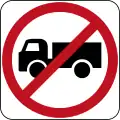 |
 |
 |
 |
 |
 |
 |
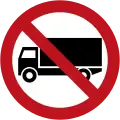 |
 |
 |
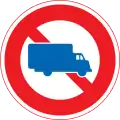 |
 |
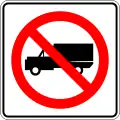 |
 |
? |  |
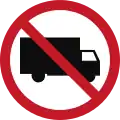 |
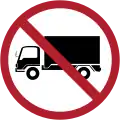 |
 |
? |  |
| Argentina | Australia | Brazil | Canada | Canada (British Columbia) |
Canada (Ontario) |
Canada (Quebec) |
Chile | Colombia | Indonesia | Ireland | Japan | Malaysia | Mexico | New Zealand | Panama | Peru | Philippines | Thailand | USA | USA (Puerto Rico) |
Uruguay | |
| Maximum speed limit |  |
.svg.png.webp) |
 |
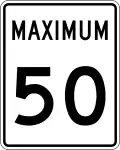 |
 |
 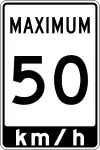 (optional) |
 |
.svg.png.webp) |
 |
.svg.png.webp) |
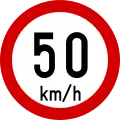 |
.svg.png.webp) |
 |
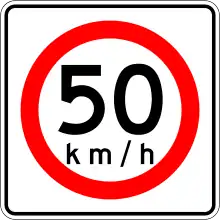 |
.svg.png.webp) |
 |
 |
.svg.png.webp) |
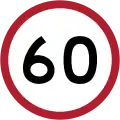 |
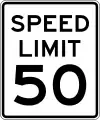 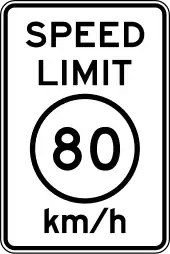 [lower-alpha 10] |
? |  |
| Minimum speed limit | 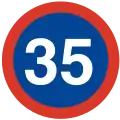 |
Not used | ? |  |
Not used | Not used |  |
.svg.png.webp) |
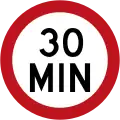 |
 |
Not used | .svg.png.webp) |
Not used | ? | Not used | ? | ? | .svg.png.webp) |
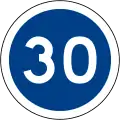 |
  [lower-alpha 10] |
? | ? |
| Speed restriction ends | ? | .svg.png.webp) |
Not used | Not used |  |
Not used | Not used | Not used | Not used | _b11a_.svg.png.webp) |
Not used | _and_507-C.svg.png.webp) or _and_507-A.svg.png.webp) |
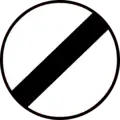 |
Not used |  |
? | ? | .svg.png.webp) |
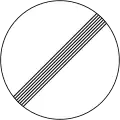 |
 |
? | ? |
| Maximum height |  |
 |
 |
 |
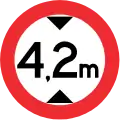 |
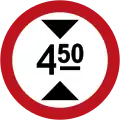 |
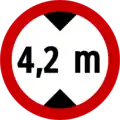 |
 |
 |
 |
 |
.svg.png.webp) |
 |
 |
 |
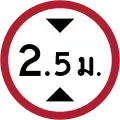 |
? |  | ||||
| Maximum width |  |
Not used |  |
Not used | Not used | Not used |  |
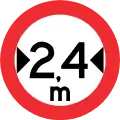 |
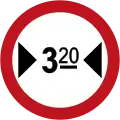 |
 |
 |
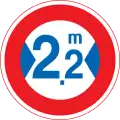 |
 |
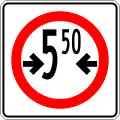 |
Not used |  |
 |
 |
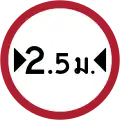 |
Not used | ? |  |
| Maximum weight | .svg.png.webp) |
 |
 |
 |
 |
 |
 |
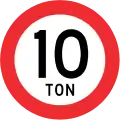 |
 |
 |
 |
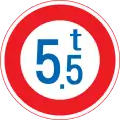 |
 |
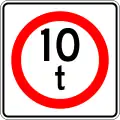 |
? |  |
 |
 |
 |
 |
 |
 |
| Maximum weight per axle | .svg.png.webp) |
 |
 |
 |
 |
 |
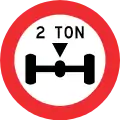 |
? |  |
 |
Not used | Not used | ? | ? |  |
 |
Not used | ? |  |
? |  | |
| Argentina | Australia | Brazil | Canada | Canada (British Columbia) |
Canada (Ontario) |
Canada (Quebec) |
Chile | Colombia | Indonesia | Ireland | Japan | Malaysia | Mexico | New Zealand | Panama | Peru | Philippines | Thailand | USA | USA (Puerto Rico) |
Uruguay | |
| No left turn | .svg.png.webp) |
 or  |
 |
 |
 |
 |
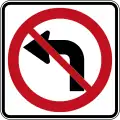 |
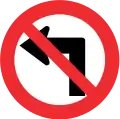 |
 |
 |
 |
Not used [lower-alpha 11] |
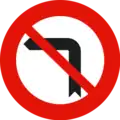 |
 |
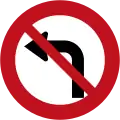 |
 |
 |
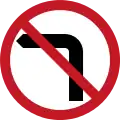 or  |
 |
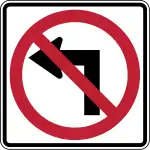 |
? |  |
| No right turn | .svg.png.webp) |
 or  |
 |
 |
 |
 |
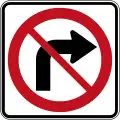 |
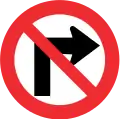 |
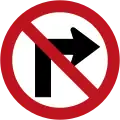 |
 |
 |
Not used [lower-alpha 11] |
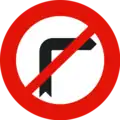 |
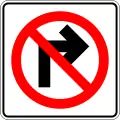 |
 |
 |
 |
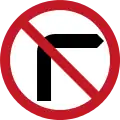 or  |
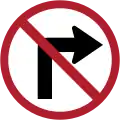 |
 |
? |  |
| No U-turn |  |
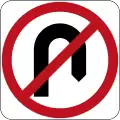 or  |
 |
 |
 |
 |
 |
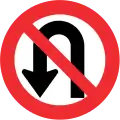 |
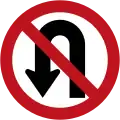 |
_4e.svg.png.webp) |
 |
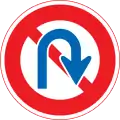 |
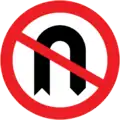 |
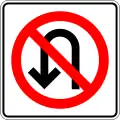 |
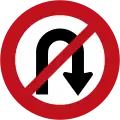 |
 |
 |
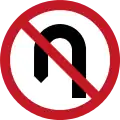 or  |
 |
 |
? |  |
| No parking |  |
 |
 |
 |
 |
 |
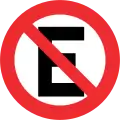 |
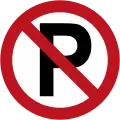 |
_3b.svg.png.webp) |
 |
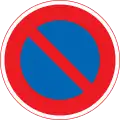 |
 |
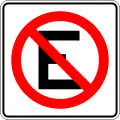 |
 |
 |
 |
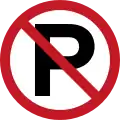 or  |
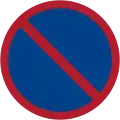 |
  |
? |  | |
| No stopping |  |
 |
 |
 |
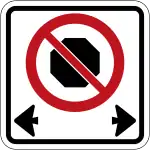 |
 |
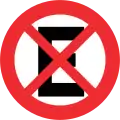 |
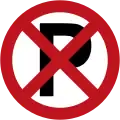 |
_3a.svg.png.webp) |
 |
 |
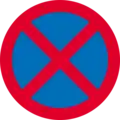 |
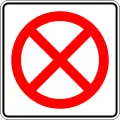 |
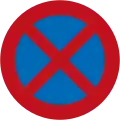 |
 |
 |
 |
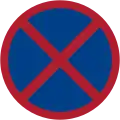 |
 |
? |  | |
| No overtaking [lower-alpha 12] |
 |
 |
 |
 |
 |
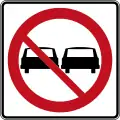 |
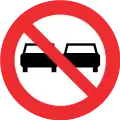 |
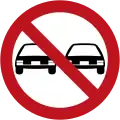 |
 |
 |
 |
 |
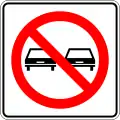 |
 |
 and  [lower-alpha 13] |
 and  [lower-alpha 13] |
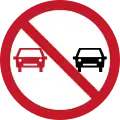 or  |
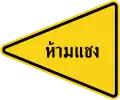 or 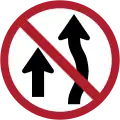 |
 or  [lower-alpha 13] |
 |
 | |
| Argentina | Australia | Brazil | Canada | Canada (British Columbia) |
Canada (Ontario) |
Canada (Quebec) |
Chile | Colombia | Indonesia | Ireland | Japan | Malaysia | Mexico | New Zealand | Panama | Peru | Philippines | Thailand | USA | USA (Puerto Rico) |
Uruguay | |
Mandatory or permitted actions
Argentina |
Australia |
Brazil |
Canada |
Canada - British Columbia |
Canada - Ontario |
Canada - Quebec |
Chile |
Colombia |
Indonesia |
Ireland |
Japan |
Malaysia |
Mexico |
New Zealand |
Panama |
Peru |
Philippines |
Thailand |
United States |
Uruguay | |
|---|---|---|---|---|---|---|---|---|---|---|---|---|---|---|---|---|---|---|---|---|---|
| Proceed straight (no turns) |
.svg.png.webp) |
 |
 |
 |
 |
Not used [lower-alpha 14] |
 |
Not used | 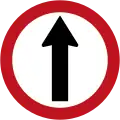 |
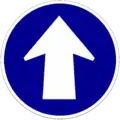 |
 |
 |
 |
? | 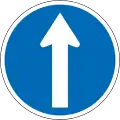 |
 |
 |
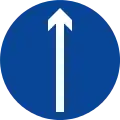 or  |
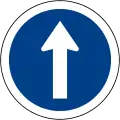 |
  |
 |
| Turn right | .svg.png.webp) |
Not used |  |
 |
 |
Not used | ? |  |
? |  |
 |
Not used | ? | 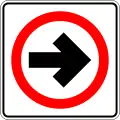 |
Not used |  |
? |  |
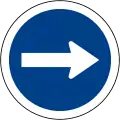 |
 |
 |
| Turn right ahead |
.svg.png.webp) |
 |
 |
 |
Not used | Not used [lower-alpha 14] |
 |
Not used | 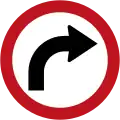 |
 |
 |
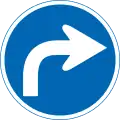 |
? | 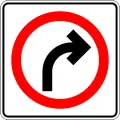 |
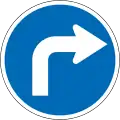 |
 |
 |
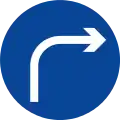 or  |
 |
 |
 |
| Proceed straight or right |
 |
Not used |  |
 |
Not used | Not used [lower-alpha 14] |
 |
Not used | Not used | 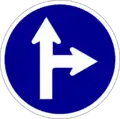 |
Not used | 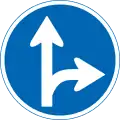 |
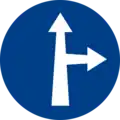 |
? | .svg.png.webp) |
Not used | Not used | Not used | Not used |  |
Not used |
| Keep right (or left) |
.svg.png.webp) |
 |
 |

|
 |
 |
 |
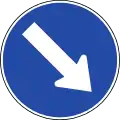 |
 |
 |
 |
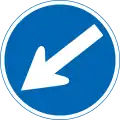 |
 |
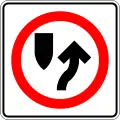 |
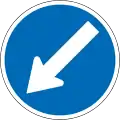 |
 |
Not used |  or  |
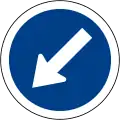 |
  |
 |
| Pass on either side |
 |
 |
 |
 |
 |
 |
 |
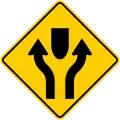 |
 |
 |
Not used | 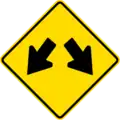 |
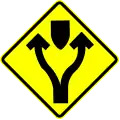 |
 |
? |  |
 |
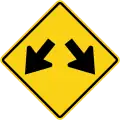 or  |
 |
 | |
| Roundabout | Not used |  |
 |
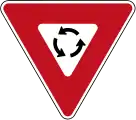 |
 |
 |
 |
 |
 |
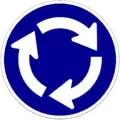 |
 |
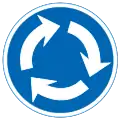 |
 |
 |
.svg.png.webp) |
 |
Not used |  or  |
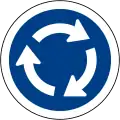 |
 |
 |
| Overtaking permitted [lower-alpha 12] |
 |
or |
 |
 |
 |
 |
 |
 |
 |
_b11b.svg.png.webp) |
 |
 |
or |
? | 
or |
? | ? | Not used |  |
 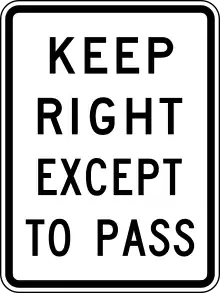 |
? |
| Shared use path | .svg.png.webp) |
 |
 |
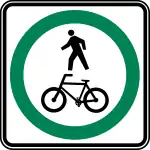 |
 |
 |
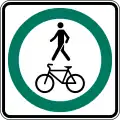 |
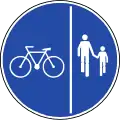 |
 |
 |
 |
 |
? | ? |  |
? | ? | Not used | ? |  |
? |
| Bicycles only | .svg.png.webp) |
 |
 |

|
 |
 |
 |
 |
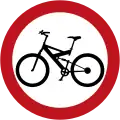 |
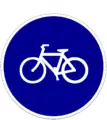 |
 |
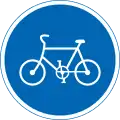 |
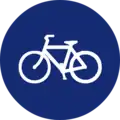 |
? | 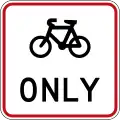 |
 |
 |
 |
 |
 | |
| Transit only | .svg.png.webp) |
 |
 |
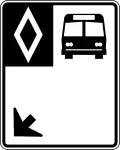 |
 |
 |
 |
 |
? | 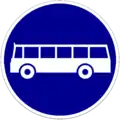 |
? | .svg.png.webp) |
? | ? | 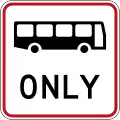 |
? |  |
? |  |
 |
? |
| Argentina | Australia | Brazil | Canada | Canada (British Columbia) |
Canada (Ontario) |
Canada (Quebec) |
Chile | Colombia | Indonesia | Ireland | Japan | Malaysia | Mexico | New Zealand | Panama | Peru | Philippines | Thailand | USA | Uruguay |
Other (indication)
Argentina |
Australia |
Bolivia |
Brazil |
Canada |
Canada - British Columbia |
Canada - Ontario |
Canada - Quebec |
Chile |
Colombia |
Indonesia |
Ireland |
Japan |
Malaysia |
Mexico |
New Zealand |
Panama |
Paraguay |
Peru |
Philippines |
Thailand |
United States |
Uruguay | |
|---|---|---|---|---|---|---|---|---|---|---|---|---|---|---|---|---|---|---|---|---|---|---|---|
| One-way street |
 |
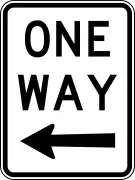 |
? |  |
or
|
Not used | ? | ? |  |
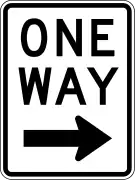 |
|||||||||||||
| Two-way traffic |
 |
 |
? |  |
 |
 |
 |
 |
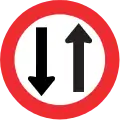 |
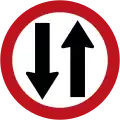 |
Not used | Not used | Not used | Not used | 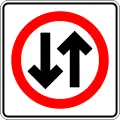 |
Not used |  |
? |  |
 or  |
Not used | [lower-alpha 9] |
 |
| Freeway begins |  |
? | Not used | Not used | Not used | Not used | 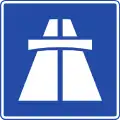 |
? | 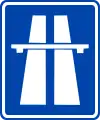 |
 |
Not used | 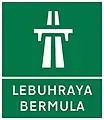 |
? | or |
? | ? |  |
 |
 | ||||
| Freeway ends |  |
? | Not used | ? | ? | ? |  |
? |  |
 |
Not used | 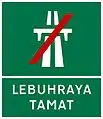 |
? | ? | ? | ? |  |
 |
 |
 | |||
| Dead end |  |
? |  |
 or 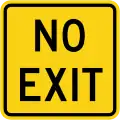 |
 |
 |
? | ? |  |
 |
Not used |  |
? | 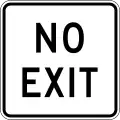 |
 |
? | ? | 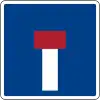 |
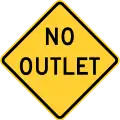 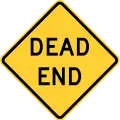 |
? | |||
| Parking zone |  or  |
 |
? |  |
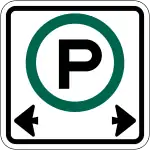 |
 |
 |
 or  |
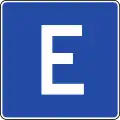 |
.svg.png.webp) |
 |
 or  (limited) (limited) |
.svg.png.webp) or .svg.png.webp) |
.jpg.webp) |
 or 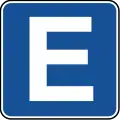 |
.svg.png.webp) |
 or  |
? |  or  |
 |
? |   |
 |
| Bus stop |  |
 |
? | .svg.png.webp) |

Some-places? |
 |
? | ? | ? | .svg.png.webp) |
 |
? |  |
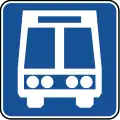 |
.svg.png.webp) |
 |
? |  |
 |
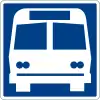 |
 |
 | |
| Train station |  |
 |
? | .svg.png.webp) |
 |
 |
 |
 |
 |
.svg.png.webp) |
 |
? |  |
? | 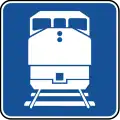 |
? |  |
? | ? | ? | 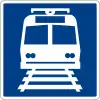 |
 |
? |
| Airport |  |
 |
? | .svg.png.webp) |
 |
 |
 |
 |
 |
.svg.png.webp) |
 |
? | Not used | .jpg.webp) |
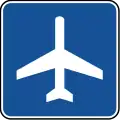 |
? |  |
? | ? | ? | .svg.png.webp) |
 |
 |
| Hospital |  |
 |
? | .svg.png.webp) |
 |
 |
 |
 |
 |
.svg.png.webp) |
 |
 |
Not used | .jpg.webp) |
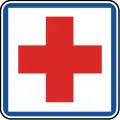 |
? |  |
? |  |
 |
 |
 |
 |
| Customs post |
 |
N/A [lower-alpha 15] |
? |  |

Sometimes I think? |
Not used | Not used |  |
 |
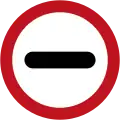 |
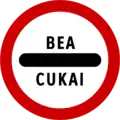 |
Not used | N/A [lower-alpha 15] |
? | 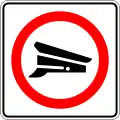 |
N/A [lower-alpha 15] |
 |
? |  |
? |  |
Not used |  |
| National highway shield(s) |
 |
 |
 |
.svg.png.webp) |
 |
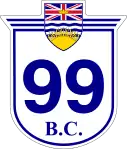 |
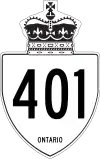 |
  |
.svg.png.webp) .svg.png.webp) |
 |
 |
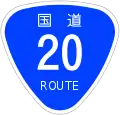 |
 |
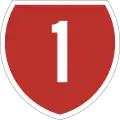 |
  |
 |
 |
 (national highway)  (tolled motorway)  (free motorway) |
  |
 | |||
| Argentina | Australia | Bolivia | Brazil | Canada | Canada (British Columbia) |
Canada (Ontario) |
Canada (Quebec) |
Chile | Colombia | Indonesia | Ireland | Japan | Malaysia | Mexico | New Zealand | Panama | Paraguay | Peru | Philippines | Thailand | USA | Uruguay |
See also
Notes
- Compare Bicycles Only (Ciclovia) sign in Brazil:
 with No Bicycles (Verbot für Radfahrer) sign in Germany:
with No Bicycles (Verbot für Radfahrer) sign in Germany: 
- In the US, "roundabout" and "traffic circle" are used interchangeably, along with "rotary". See Roundabout terminology.
- No distinction between controlled and uncontrolled railroad crossings is made.
- There are no operating tram or streetcar systems in this jurisdiction.
- Used in California only. Shared grade tram or streetcar crossings are typically unsigned in other jurisdictions.
- Text varies.
- Not in use for road vehicles
- Off-road tracks only
- Temporary use only.
- The metric version of the sign is not in general use—it is included to show the use of the more internationally recognized circle used in speed limit signs. One example of use is on the Sault Ste. Marie International Bridge, north of the Canada–US border but south of Canada Customs.
- Japan indicates movement restrictions by means of mandatory signs only:
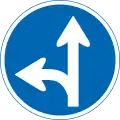
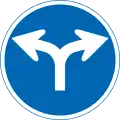

- In many jurisdictions, "Overtaking Permitted" is indicated solely through a change in road markings, e.g. a solid center line changing to a dashed center line. In such jurisdictions, signs in this category are only posted in locations where a change in road markings is deemed insufficient notice for drivers. This is in contrast to "No Overtaking" signs, which are almost always posted alongside changes in road markings to indicate the end of an overtaking zone.
- Pennant signs are placed facing traffic in the passing lane, i.e. on the left side of the road for right-hand driving countries. They are used in conjunction with standard-shaped signs placed facing traffic in the travel lane, i.e. on the right side of the road.
- Ontario indicates movement restrictions by means of prohibitory signs only:



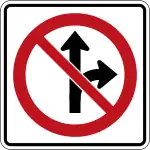
- This country has no land borders.
References
- Manual on Uniform Traffic Control Devices, 2009 Edition
- "Part I: Convention on Road Signs and Signals – Annex 3" (PDF). United Nations. p. 83.
- Ireland Department of Transport, Tourism, and Sport – Traffic Signs Manual, Chapter 1
- Ontario Ministry of Transportation – Bilingual Signing Policy
- New Zealand Ministry of Transport – Manual of Traffic Signs and Markings, Sec. 7.7
- British Columbia Manual of Standard Traffic Signs & Pavement Markings
- MUTCD History
- "QLD regulatory signs". Queensland Government. Government of Queenland.



